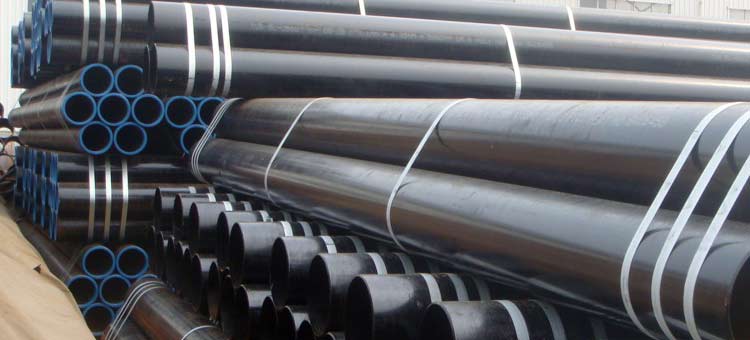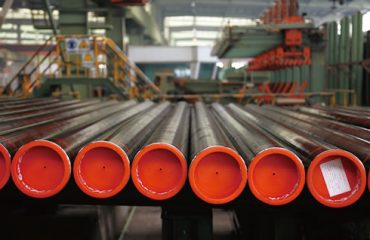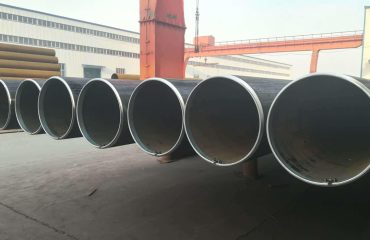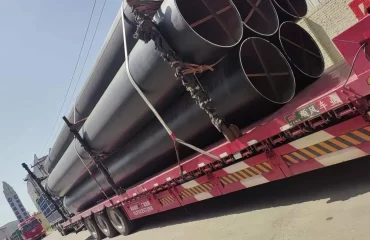
ASTM A672 Электромуфтовая сварка (EFW) стальная труба
Введение
ASTM A672 — это спецификация, охватывающая электросварку плавлением. (EFW) стальные трубы, предназначенные для работы под высоким давлением при умеренных температурах. Эти трубы обычно используются в таких отраслях, как производство электроэнергии., нефтехимической, нефти и газа, и передача воды. Спецификация содержит рекомендации по изготовлению, тестирование, и проверка стальных труб на предмет их соответствия необходимым механическим свойствам и эксплуатационным требованиям для применения под высоким давлением..
Процесс EFW — это метод сварки, при котором для соединения стальных пластин используется электрическая дуга., формирование продольного шва. Этот процесс очень эффективен и позволяет производить трубы с превосходной структурной целостностью и механической прочностью.. Трубы ASTM A672 доступны в различных марках в зависимости от типа используемой стали и требуемых механических свойств..
В этой статье будет рассмотрен процесс производства., Механические свойства, и применение стальных труб ASTM A672 EFW, а также методы тестирования, используемые для обеспечения их качество и производительность.
Оглавление
- Что такое стальная труба ASTM A672 EFW?
- Процесс производства стальной трубы ASTM A672 EFW
- Электросварка плавлением (EFW) Процесс
- термическая обработка
- Марки и классы стальных труб ASTM A672
- Механические свойства стальной трубы ASTM A672 EFW
- Требования к испытаниям и проверкам
- неразрушающий контроль (неразрушающий контроль)
- Гидростатические испытания
- Применение стальной трубы ASTM A672 EFW
- Часто задаваемые вопросы (Часто задаваемые вопросы)
- Заключение
Что такое стальная труба ASTM A672 EFW? {#что такое-astm-a672-efw-стальная труба}
ASTM A672 — это стандартная спецификация для электросварки плавлением. (EFW) стальные трубы, предназначенные для работы под высоким давлением при умеренных температурах. Эти трубы изготовлены из сосуда под давлением. качество стальные пластины, сваренные плавлением с использованием электрической дуги. Спецификация охватывает трубы продольным швом и предназначена для использования в приложениях, где требуется высокая прочность и долговечность.
Ключевые особенности стальной трубы ASTM A672 EFW:
-
Электрическое сварение сварено (EFW): Трубы изготавливаются с использованием процесса EFW, который включает в себя слияние стальных пластин с использованием электрической дуги. Этот процесс создает сильный продольный сварка, который может выдерживать высокое давление.
-
сосуд под давлением качество Сталь: Стальные пластины, используемые при производстве труб ASTM A672, имеют качество сосуда давления, Это означает, что они предназначены для выдержания высокого внутреннего давления без сбоя.
-
Служба высокого давления: Трубы ASTM A672 подходят для применений высокого давления, такие как котлы, Теплообменники, и трубопроводы в нефтегазовой промышленности.
-
Умеренные температурные применения: Спецификация покрывает трубы, предназначенные для использования при умеренных температурах, обычно до 400 ° C (752° F).
-
Различные оценки: Трубы ASTM A672 доступны в разных сортах на основе типа используемой стали и необходимых механических свойств. Оценки определяются химическим составом и термической обработкой стали.
Процесс производства стальной трубы ASTM A672 EFW {#Производство-процесс-процесс ASTM-A672-EFW-Steel-Pipe}
Производство стальных труб ASTM A672 EFW включает в себя несколько этапов, в том числе выбор стальных тарелок качества сосуда под давлением, Электрическая сварка (EFW) Процесс, и термообработка для достижения желаемых механических свойств.
Электросварка плавлением (EFW) Процесс {#Электрический фьюжн-Welding-EFW-процесс}
Процесс EFW - это тип дуговой сварки, которая использует электрическую дугу, чтобы объединить стальные пластины вместе вдоль продольного шва. Процесс включает в себя следующие шаги:
-
Подготовка к тарелке: Стальные пластины сначала разрезаны до необходимых размеров и проверены на любые поверхностные дефекты или недостатки.
-
Подготовка к краю: Края стальных пластин скоплены, чтобы обеспечить правильное слияние во время сварки. Угол скоси тщательно контролируется для достижения сильного сварка.
-
Электросварка плавлением: Пластины расположены к краю до края, и электрическая дуга используется для таяния краев пластин, Создание сварного бассейна. Когда дуга движется вдоль шва, расплавленный металл затвердевает, формирование непрерывного сварка вдоль длины трубы.
-
Сварная проверка: Сварная сварка проверяется на такие дефекты, как пористость, трещины, или неполное слияние. Неразрушающий контроль (неразрушающий контроль) методы, такие как ультразвуковое тестирование или рентгенографическое тестирование, часто используются для обеспечения качества сварка.
-
Размеры и формирование: После сварки, труба пропускается через ряд роликов для достижения желаемого диаметра и округлости. Труба также проверяется на точность размеров..
термическая обработка {#термообработка}
После процедуры EFW, трубы могут подвергаться термической обработке для улучшения механических свойств и снятия остаточных напряжений, возникающих при сварке.. Вид термообработки зависит от марки стали и требований применения.. Общие процессы термообработки включают в себя:
-
Нормализация: Труба нагревается до температуры выше критической точки, а затем охлаждается на воздухе.. Этот процесс улучшает зернистую структуру и повышает ударную вязкость стали..
-
Закалка и отпуск: Труба нагревается до высокой температуры, а затем быстро охлаждается. (закаленный) в воде или масле. Затем его повторно нагревают до более низкой температуры. (закаленный) Чтобы улучшить его пластичность и прочность.
-
Снятие стресса: Труба нагревается до умеренной температуры, а затем медленно охлаждается, чтобы снять остаточные напряжения без значительного изменения механических свойств.
Марки и классы стальных труб ASTM A672 {#Оценки и классы-ASTM-A672-Steel-Pipe}
Стальные трубы ASTM A672 доступны в различных классах и классах в зависимости от типа используемой стали и необходимых механических свойств. Оценки определяются химическим составом стали, В то время как классы основаны на требованиях к термообработке и тестированию.
Общие оценки:
-
Степень B60: Этот сорт сделан из углеродистой стали с минимальной прочностью растяжения 415 MPA (60,000 пси). Обычно используется для приложений умеренного давления.
-
Класс C65: Этот сорт изготовлен из углеродной стали с минимальной прочностью на растяжение 450 MPA (65,000 пси). Подходит для приложений с более высоким давлением.
-
Класс C70: Этот сорт изготовлен из углеродной стали с минимальной прочностью на растяжение 485 MPA (70,000 пси). Он используется в приложениях высокого давления, где прочность и долговечность имеют решающее значение.
Классы:
- Класс 10: Трубы в этом классе поставляются в стержнем состоянии без тепловой обработки.
- Класс 12: Трубы в этом классе подвергаются тепловой обработке после сварки, чтобы улучшить их механические свойства и снять остаточные напряжения.
- Класс 22: Трубы в этом классе подвергаются утолке и отпуска, чтобы достичь более высокой силы и прочности.
Спецификация материала {#Спецификация материала}
ASTM A672 трубы сделаны из качественные стальные тарелки с под давлением которые сварены с помощью Электросварка плавлением (EFW) Процесс. Спецификация покрывает трубы в различных Классы и Классы, которые определяются Химический состав стали и термическая обработка применяется после сварки.
Ключевые особенности стальной трубы ASTM A672 EFW:
- Электрическое сварение сварено (EFW): Трубы сварены с помощью Электрическая дуга чтобы объединить стальные тарелки, Создание а продольный сварка.
- Качественное сосуд давления сталь: Используемые стальные пластины качество сосуда под давлением, обеспечение того, чтобы трубы выдерживали высокое внутреннее давление.
- Служба высокого давления: Трубы ASTM A672 предназначены для приложения высокого давления в умеренные температуры.
- Оценки и классы: В спецификации предусмотрено несколько Классы и Классы на основе Химический состав и термическая обработка из стали.
Таблица химического состава {#таблица химического состава}
Химический состав стальных труб ASTM A672 варьируется в зависимости от Класс из использованной стали. В таблице ниже приведен типичный химический состав обычных марок, используемых в трубах ASTM A672..
| Элемент | Степень B60 (%) | Класс C65 (%) | Класс C70 (%) |
|---|---|---|---|
| УГЛЕРОД (C) | 0.26 Макс | 0.24 Макс | 0.23 Макс |
| марганец (MN) | 0.98 Макс | 1.20 Макс | 1.35 Макс |
| фосфор (P) | 0.035 Макс | 0.035 Макс | 0.035 Макс |
| серы (S) | 0.035 Макс | 0.035 Макс | 0.035 Макс |
| кремний (Si) | 0.13-0.45 | 0.13-0.45 | 0.13-0.45 |
| хром (CR) | 0.30 Макс | 0.30 Макс | 0.30 Макс |
| никель (Ni) | 0.30 Макс | 0.30 Макс | 0.30 Макс |
| Молибден (Mo) | 0.12 Макс | 0.12 Макс | 0.12 Макс |
| Медь (Cu) | 0.40 Макс | 0.40 Макс | 0.40 Макс |
| Ванадий (V) | 0.08 Макс | 0.08 Макс | 0.08 Макс |
Заметки:
- Содержание углерода является ключевым фактором, определяющим Прочность и Твердость из стали. Более низкое содержание углерода улучшает свариваемость и пластичность.
- марганец улучшает Прочность на растяжение и прокаливаемость из стали.
- фосфор и серы поддерживаются на низком уровне, чтобы предотвратить хрупкость и улучшить прочность.
- кремний действует как раскислитель в процессе производства стали и улучшает Прочность.
Таблица механических свойств {#таблица механических свойств}
Механические свойства стальных труб ASTM A672 определяются Класс и Класс трубы, а также термическая обработка применяется после сварки. В таблице ниже приведены типичные механические свойства для общих классов труб ASTM A672.
| Свойство | Степень B60 | Класс C65 | Класс C70 |
|---|---|---|---|
| Прочность на растяжение (MPA) | 415 мин (60,000 пси) | 450 мин (65,000 пси) | 485 мин (70,000 пси) |
| Предел текучести (MPA) | 240 мин (35,000 пси) | 275 мин (40,000 пси) | 275 мин (40,000 пси) |
| относительное удлинение (%) | 22 мин | 22 мин | 22 мин |
| Ударная вязкость (J) | Варьируется в классе | Варьируется в классе | Варьируется в классе |
Заметки:
- Прочность на растяжение максимальное напряжение, которое материал может выдержать перед ломами.
- Предел текучести это стресс, при котором материал начинает деформировать пластично.
- относительное удлинение является мерой пластичности материала, Указывая, сколько он может растянуть, прежде чем сломаться.
- Ударная вязкость обычно измеряется с использованием Чарпи V-Notch Tests, Особенно для приложений в низкотемпературная среда.
Требования к испытаниям и проверкам {#тестирование и инсекция-реквизиты}
Для обеспечения качества и производительности стальных труб ASTM A672 EFW, Несколько методов тестирования и проверки используются в процессе производства. Эти тесты помогают определить любые дефекты или несоответствия в материале или сварке, которые могут поставить под угрозу механические свойства трубы или целостность структурной.
неразрушающий контроль (неразрушающий контроль) {#неразрушающий контроль-NDT}
неразрушающий контроль (неразрушающий контроль) применяются методы проверки сварного шва и тела трубы на наличие дефектов без повреждения материала.. Общие методы неразрушающего контроля включают в себя:
-
Ультразвуковой контроль (OUT): Ультразвуковые волны используются для обнаружения внутренних дефектов, таких как трещины., пустоты, или неполное проваривание сварного шва или тела трубы.
-
Радиографическое тестирование (RT): Рентгеновские лучи или гамма-лучи используются для создания изображения сварного шва., позволяя инспекторам выявлять внутренние дефекты, такие как пористость, шлаковые включения, или трещины.
-
Магнитопорошковое тестирование (МТ): Этот метод используется для обнаружения поверхностных дефектов в ферромагнитных материалах.. К трубе приложено магнитное поле., частицы железа используются для выявления трещин и дефектов на поверхности..
-
Капиллярное тестирование (ПТ): На поверхность трубы наносится краситель., Любые трещины и дефекты впитают краску., делая их видимыми в ультрафиолетовом свете.
Гидростатические испытания {#гидростатические испытания}
Гидростатическое тестирование является критическим тестом, используемым для обеспечения того, чтобы труба может противостоять внутреннему давлению, которому она будет подвергнута в эксплуатации. Во время этого теста, труба заполнена водой и под давлением до уровня выше ее рабочего давления. Труба затем проверяется на любые утечки или деформации, которые могут указывать на слабость в материале или сварке.
- Испытательное давление: Испытательное давление обычно 1.5 Время конструктивного давления трубы.
- Продолжительность: Труба удерживается при испытательном давлении в течение определенного периода (обычно 5 Кому 15 протокол) Чтобы убедиться, что он может поддерживать давление без сбоя.
Применение стальной трубы ASTM A672 EFW {#Приложения-astm-A672-EFW-Steel-Pipe}
ASTM A672 EFW Стальные трубы используются в широком спектре отраслей и применения, где обслуживание высокого давления и целостность структурных. Некоторые распространенные приложения включают в себя:
-
выработка энергии: Трубы ASTM A672 используются в котлах, Теплообменники, и паровые трубопроводы в электростанциях из -за их способности выдерживать высокие давления и умеренные температуры.
-
нефтехимическая промышленность: Эти трубы используются на нефтеперерабатывающих заводах, химические заводы, и нефтехимические средства для транспортировки коррозийных жидкостей и газов под высоким давлением.
-
Нефтегазовая промышленность: Трубы ASTM A672 используются в нефтегазовых трубопроводах, Морские платформы, и подводные трубопроводы для транспортировки сырой нефти, натуральный газ, и другие углеводороды.
-
Водопроводная передача: Эти трубы используются в системах передачи воды для транспортировки питьевой воды, сточные воды, и промышленная вода под высоким давлением.
-
Структурные применения: Трубы ASTM A672 используются в структурных приложениях, таких как столбцы, балки, и поддержки в зданиях и промышленных сооружениях, где требуется прочность и долговечность.
Часто задаваемые вопросы (Часто задаваемые вопросы) {#Часто задаваемые вопросы}
1. В чем разница между трубами EFW и ERW?
EFW (Электрическое сварение сварено) Трубы сварены с использованием электрической дуги для объединения стальных пластин, пока ERW (Электросварные) Трубы сварены с использованием электрической сопротивления, чтобы нагреть края стали и объединить их вместе. Трубы EFW обычно используются для приложений высокого давления, В то время как трубы ERW используются для применений с низким или умеренным давлением.
2. Каковы общие оценки труб ASTM A672?
Общие оценки труб ASTM A672 включают в себя B60, Класс C65, и класс C70, которые основаны на химическом составе и механических свойствах стали.
3. Какова максимальная рабочая температура для труб ASTM A672?
Трубы ASTM A672 предназначены для использования при умеренных температурах, обычно до 400 ° C (752° F), в зависимости от оценки и класса трубы.
4. Как обеспечивается качество труб ASTM A672?
Качество труб ASTM A672 обеспечивается неразрушающим тестированием (неразрушающий контроль) такие методы, как ультразвуковой контроль, Радиографическое тестирование, и тестирование магнитных частиц, а также гидростатическое тестирование, чтобы проверить способность трубы выдерживать внутреннее давление.
5. Что отрасли используют ASTM A672 EFW Стальные трубы?
ASTM A672 EFW Стальные трубы используются в таких отраслях, как производство электроэнергии, нефтехимической, нефти и газа, и передача воды из -за их способности выдерживать высокие давления и умеренные температуры.
Заключение {#Заключение}
Стальные трубы ASTM A672 предназначены для обслуживания высокого давления при умеренных температурах, Сделать их идеальными для использования в таких отраслях, как производство электроэнергии, нефтехимической, нефти и газа, и передача воды. Электрическая сварка (EFW) Процесс обеспечивает сильный продольный сварка, который может выдерживать высокое внутреннее давление, В то время как использование стали качества сосуда давления гарантирует, что трубы обладают необходимыми механическими свойствами для требовательных применений.
Требования к тестированию и проверке, изложенные в ASTM A672, включая неразрушающий контроль и гидростатические испытания, помогают обеспечить качество и работоспособность труб, что делает их надежным выбором для применения в условиях высокого давления и в строительных конструкциях..




Ты должен быть вошли в систему опубликовать комментарий.